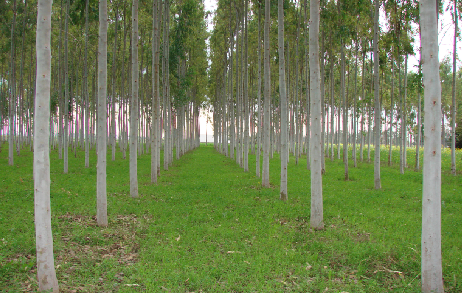
Eucalyptus a Saviour of Forests
- March 22, 2021
- 0

EUCALYPTUS plantation cover about 10 million ha2 area in about 100 countries. Brazil is a leader (40%) in growing various species of eucalyptus, while India stands second accounting for about 8 per cent of the global coverage. This genus is endemic to Australia and has more than 600 species whose climatic requirements vary from tropical to warm temperate and annual rainfall varying from 200-5000 mm. On an average, annual growth of 10-15 m3/ha of stemwood is commonly obtained from eucalyptus plantations in temperate and tropical regions. With an assumption of wood density 400 kg/m3, the annual yield of world’s eucalyptus plantations is about 30 million tonnes of dry wood.
Eucalyptus was introduced in India during 1782-90 at Nandi Hills in Mysore. It has spread over to the states of Uttar Pradesh, Karnataka, West Bengal, Bihar, Punjab, Haryana Madhya Pradesh, Gujarat, Maharashtra, Tamil Nadu and Kerala, and has occupied about 7.5 lakh hectares of forest and farmlands. About two per cent of the cultivable land has been brought under Eucalyptus hybrid plantations in the North Western region. It gained adverse publicity despite its high productivity and widespread plantations. Even a layman, who was not concerned with its cultivation, used to make negative comments about it like, “it sucks water” or “it spoils farmlands.” Why this tree which has been serving humanity and environment in the best possible manner, was being criticised unnecessarily?
 Why eucalyptus?
Why eucalyptus?
The average annual productivity of natural forests in India is 0.5 m3/ha, while the average productivity of seed-root eucalyptus plantations is 10 m3/ha on forest lands and 15 m3/ha on farmlands, while it is 25 m3/hain case of clonal eucalyptus on farmlands. Still, it is undesirable ecologically to replace natural forests with the plantations of eucalyptus but there is nothing wrong if its cultivation is carried out on farmlands. It has faster growth, which not only leads to more absorption of carbon dioxide but also more production of oxygen, resulting in more efficient pollution control in shorter duration and ultimately leading to conservation of environment.
The scientific management of forestry in India is more than 150 years old but eucalyptus is one of the first tree species which has been adopted by the farmers for cultivation on farmlands on a large scale due to its lower effect on productivity of agricultural crops, faster growth, shorter harvesting period, and easier marketing. Hence, eucalyptus, has been adopted on farmlands due to its compatibility with agricultural crops.
Charges against eucalyptus
The criticism against eucalyptus that it lowers the ground water table lacks scientific basis. During 2017-18, the net irrigated area in Haryana was 32.6 lakh ha which was 2.5 times of irrigated area in 1966-67. The irrigated area with canals increased by 22 per cent only, while it increased by 610 per cent in case of tube wells during this period. There was an explosion in the number of tube wellsi.e.8.2 lakh in 2017-18which was 33 times of tube wells in 1966-67.
The water table in north-eastern Haryana is declining because the main source of irrigation in this region is tube wells, while it is rising in western Haryana because it is mainly irrigated with canals. So, the real cause of decline in water table is not poor eucalyptus, but the exponential growth of tube well switch are needed for agriculture.
Paddy needs about 4500 litres of water for producing one kg of the grain and wheat needs 1500 litres, but eucalyptus needs only 511 litres of water for producing one kg of wood. Despite its higher requirement of water, paddy cultivation is quite popular in the food basket (Punjab, Haryana and Western UP)of the country because it is economically more beneficial to farmers. Similarly, eucalyptus has also been adopted by farmers in this region on economic considerations.
Management of eucalyptus
It should be planted in well drained sandy loam soils whose pH should not be more than 8.5. Sandy soils are not suitable for its cultivation if irrigation facilities are not available. Saplings should be planted at a spacing of 1.5 m in north-south direction on bunds to minimise the loss in agricultural production. Initially, watering should be done at an interval of 7 to 10 days but after the establishment of plants, monthly watering except during rainy season, is needed in the first year. The harvesting of clonal eucalyptus plantations at spacing of 3mx1.5m and 3mx2m, can be done on completion of about 4 and 6 years for producing poles, posts and pulpwood, and peeling wood, respectively. To maximise the profits, intensive management of plantations should be undertaken to reduce their rotation period which will be more profitable to the farmers.
Eucalyptus is presently being used for making plywood, hard-boards, and particle boards. It is also used as a construction timber, small timber, poles and posts, pulpwood, and firewood. It is suitable for packing cases, crates, boxes, beams, columns, etc. Even it is being used for furniture, doors and window frames. It also provides nectar for honeybees and oils and tannins for perfumes and medicines.
The rise and fall of eucalyptus
Despite adverse publicity, agitations and propaganda, eucalyptus has survived not only in forests but also on farmlands. As far as agro-forestry is concerned, the farmers are great observers and entrepreneurs and learn fast from the experience of others. They have developed agro-forestry models and modified its package of practices to reduce the loss in agricultural production. Under rainfed conditions, its cultivation is a safer investment than agricultural crops, while on irrigated farmlands, its agro-forestry models are more profitable than agricultural crops. Its cultivation got a setback during early eighties when its market prices crashed due to glut in the market. The faulty package of practices and low prices resulted into inadequate returns to the farmers. To counter this situation, the state government of Haryana established Haryana Forest Development Corporation which declared support prices for eucalyptus and promised to intervene in the market if its prices fell below the support prices. The Forest Department also increased the rotation period of eucalyptus plantations in forests to 16 years, to avoid competition with farmers. Despite having only 7.8 per cent of geographical area under forest and tree cover, Haryana state is meeting the demands of apple packing cases of Himachal Pradesh, wood charcoal of J & K, and eucalyptus poles of Rajasthan.
Ex MD HFDC
Haryana Forest Development Corporation Member SEAC
State Environment Impact Assessment Authority
































































